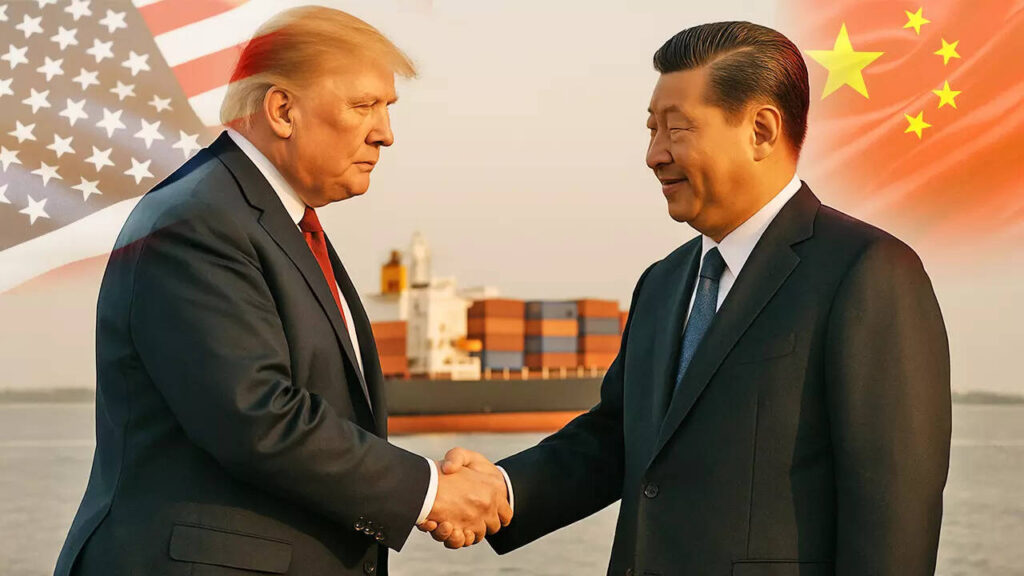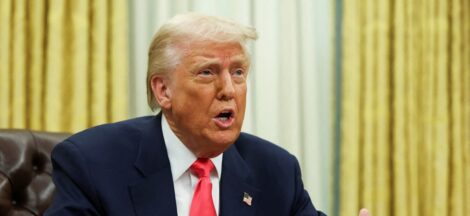By T N Ashok
NEW YORK: US President Donald Trump went to town with his announcement that his Art of the Deal with China on trade and tariffs was a Done Deal even as China chose to downplay it as the negotiations finalised at a uniform tariff of 55% tariffs for all Chinese goods imported into the USA, a far cry from the 135% tariffs imposed on the Asian giant in the trade war where US was slapped with reciprocal 125% tariffs.
Successful negotiations first in Geneva and followup talks in London between Chinese Vice Premier Hi LiFeng and US Treasury Secretary Scott Bessent, Commerce Secretary Howard Lutnick and USTR Jamieson Greer have led to a deal.
Neither country could afford a trade war as the US depends on China for a lot of products and China for sophisticated technologies and its trade dipped by a third since the tariff wars began.
But the greatest breakthrough in this deal is US access to rare earths and earth magnets and China’s conditional access to Semiconductors and visa regulations for Chinese students, which, albeit would be under scrutiny and control so that they are not diverted into defense and spying software. How Trump pulled it off is a million-dollar question but, the fact is he did but again, US importers would benefit a lot as a huge amount of diverse commodities are sourced from China as finished and intermediate products.
The baby girl can now have five to six dolls instead of just 2 dolls which Trump said she should have in an austerity measure that did not go down well with the mothers of the children.
The larger picture here is the collateral damage to India. First of all, there is a huge uncertainty over whether Apple would relocate its manufacturing facilities for iPhone to India which Tim Cook, its CEO, announced when tariffs on China hit the ceiling. But the picture has now dramatically altered.
Just as India showed flickers of progress toward its long-held dream of becoming the world’s factory hub, Washington and Beijing announced a trade “reset” that could derail Delhi’s ambitions to emerge as the global manufacturing hub in competition with China.
Last week, Trump’s tariffs on China dropped overnight – from 145% to 30%, vs 27% for India – as the two sides thrashed out an agreement in Switzerland. As a result, there’s a chance manufacturing investment that was moving from China to India could either “stall” or “head back”, feels Ajay Srivastava of the Delhi-based think tank, Global Trade Research Institute (GTRI).
“India’s low-cost assembly lines may survive, but value-added growth is in danger.”The change in sentiment stands in sharp relief to the exuberance in Delhi last month when Apple indicated that it was shifting most of its production of iPhones headed to the US from China to India. That may well still happen, even though US President Donald Trump revealed that he had told Apple CEO Tim Cook not to build in India because it was “one of the highest tariff nations in the world”.
“India is well positioned to be an alternative to China as a supplier of goods to the US in the immediate term,” Shilan Shah, an economist with Capital Economics, wrote in an investor note before the deal was announced. He pointed out that 40% of India’s exports to the US were “similar to those exported by China”.
There were early signs that Indian exporters were already stepping in to fill the gap left by Chinese producers. New export orders surged to a 14-year high, according to a recent survey of Indian manufacturers, west media reports reaching here said.
Nomura, a Japanese broking house, also pointed to growing “anecdotal evidence” of India emerging as a winner from “trade diversion and supply-chain shift in low and mid-tech manufacturing” particularly in sectors like electronics, textiles and toys.
Back to the US China trade deal. The US and China agreed to lower import taxes on goods being traded between the two countries. Some analysts do believe that despite the so-called trade “reset” between Beijing and Washington, a larger strategic decoupling between China and the US will continue to benefit India in the long run.
For one, there’s greater willingness by Narendra Modi’s government to open its doors to foreign companies after years of protectionist policies, which could provide tailwinds. India and the US are also negotiating a trade deal that could put Asia’s third-largest economy in a sweet spot to benefit from the so-called “China exodus” – as global firms shift operations to diversify supply chains.
India has just signed a trade pact with the UK, sharply cutting duties in protected sectors like whiskey and automobiles. It offers a glimpse of the concessions Delhi might offer Trump in the ongoing India-US trade talks. There is talk of a uniform 10% tariffs on US goods imported into India that could open the flood gates to fashion products from clothing to perfumes of the top brands of the world operating from Manhattan. Tommy Hilfiger, Dior, Cartier, Chanel, are some of the luxury brands that could make a dramatic debut in India at affordable prices.
So also bourbon whiskeys such as Jack Daniel that went off the racks in Canada. However, India is a savoury Scotch Whiskey from Johnny Walker Red and Black Labels to premium Glenfiddich single malt whiskeys which will now come in easily with the trade deal clinched with the UK.
All this generous optimism needs to be tempered with abundant caution. Why? Because, apart from the fact that China is now back in the running, companies are also “not entirely writing off other Asian competitors, with countries like Vietnam still on their radars”, economists Sonal Verma and Aurodeep Nandi from Nomura said in a note earlier this month, reports indicated.
“If India has to take advantage of the current US China trade situation, then it needs to capitalize on this opportunity, it needs to complement any tariff arbitrage with serious ease-of-doing-business reforms.” India’s tough business climate with not so easy to do business policies has long frustrated foreign investors and stalled India’s manufacturing growth, with its share of Gross Domestic Product (GDP) stuck at around 15% for two decades.
The Modi government’s efforts, such as the Production Linked Incentive (PLI) scheme, have delivered only limited success in boosting this figure. The government’s think tank, NITI Aayog, has acknowledged India’s “limited success” in attracting investment shifting from China. It noted that factors like cheaper labour, simpler tax laws, lower tariffs, and proactive Free Trade Agreements helped countries like Vietnam, Thailand, Cambodia, and Malaysia expand exports – while India lagged behind.
Another major concern, according to trade experts is India’s ongoing reliance on China for raw materials and components used in electronics like iPhones, limiting Delhi’s ability to fully capitalize on supply chain shifts. “India’s earnings from making iPhones will only rise if more of the phones are made locally,” BBC quoted Shrivastava as saying.
According to him, right now Apple earns over $450 per iPhone sold in the US while India keeps less than $25 – even though the full $1,000 is counted as an Indian export. “Just assembling more iPhones in India won’t help much unless Apple and its suppliers also start making components and doing high-value work here. Without that, India’s share stays small, and the export numbers go up only on paper – possibly triggering more scrutiny from the US without real economic gain for India,” Mr. Srivastava said.
Finally, there are concerns that Chinese exporters could try to use India to reroute products to the US. India doesn’t seem averse to this idea despite the pitfalls. The country’s top economic adviser said last year that the country should attract more Chinese businesses to set-up export oriented factories and boost its manufacturing industry – a tacit admission that its own industrial policy hadn’t delivered.
But experts caution, this could further curtail India’s ability to build local know-how and grow its own industrial base. All of this shows that beyond the headline-grabbing announcements by the likes of Apple, India is still a long way from realizing its factory ambitions. (IPA Service)


 India Abstaining During Voting On UN Resolution For Ceasefire In Gaza Is The Lowest Point Of Diplomacy
India Abstaining During Voting On UN Resolution For Ceasefire In Gaza Is The Lowest Point Of Diplomacy 